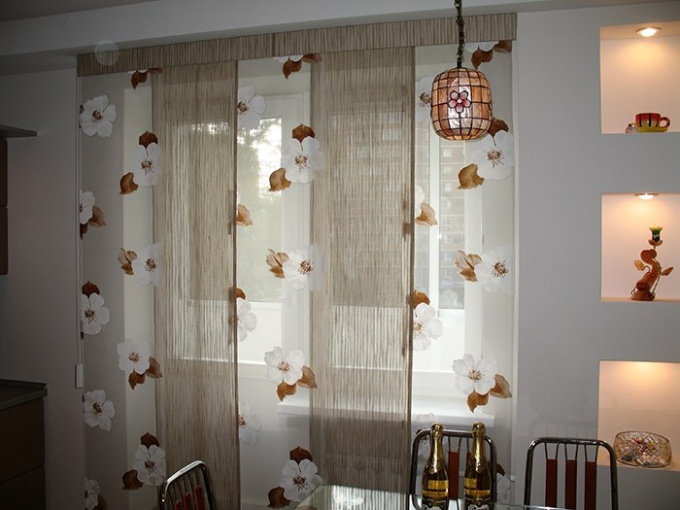Distinctive features of Japanese curtains
Japanese curtains – a quite exotic form of curtains, they are also called screen or panel. Indeed, they resemble huge screen that attracts attention. That is why the design of curtains should be stylish and original. Like Roman blinds, Japanese panels are a variety of flat curtains.
The big advantage of Japanese curtains is the ease of replacement. You can change the fabric every season. In winter, they can be cozy and dense, and in summer - light and transparent.
Japanese curtains are a mechanism consisting of a cornice and smooth of fabric that move like doors of the wardrobe. These curtains are managed in the same way as blinds with a cord or automatic mechanism.
The standard size of width of Japanese panel is 60 cm Special cornice for a screen curtain has the same width. Japanese panels don't have ruffles, clamps, accessories and various holders. This is due to the fact that the screen blinds have a direct view and a clear line that distinguishes these products from other types of curtains.
Where to hang curtains Japanese
Japanese curtains are very versatile. They can hang in the kitchen or in any room. They fit to any interior, from classic to modern. You can design the interior bedroom in the East or minimalist style, and Japanese curtains expressively underlined. Best of all, these products look great on wide Windows.
Use these curtains can not only for decoration of the window opening, but also to separate the room into zones of work and leisure. In addition, they can be used as decorative interior partitions. You can share different premises - for example, dining room and kitchen, hallway and living room.
Selection of the material and the eaves for Japanese curtains
The first step is to choose fabric and pattern. Fabric for panel curtains, choose sheer and natural light or blackout. Traditionally, for the manufacture of Japanese panels used linen, cotton, silk as well as woven jute or bamboo.
Colors should be calm, natural and soft pastel shades: beige, blue, pale green, brown. These colors are neutral and are not load. You can give preference to fabric with traditional Japanese images — willows, cherry blossoms, other flowers in the Japanese style. It is possible to use and other Oriental motifs.
Also relevant pictures of characters, which can be painted with paint for fabric, printed or stitched using the lace/cord. The pattern on the fabric should be concise, not too big and not wide. Width Japanese curtains are quite limited, so it's important to figure them fit.
You can find special detergents for Japanese curtains. These devices usually are of 2 types - allows you to shift the panels one at a time or simultaneously. The kit also often include the weights. For shear fabric panels you just need to pull a rope cord. You can choose another model of the cornice, the construction of which runs on electric.
Tailoring Japanese curtains with his hands
First cut strips of fabric width of 60 cm taking into account allowances for seams and fabric shrinkage. The seam allowance on the sides is done in the first place, because the canvas on the bottom need to trim the drawstring. It is better to make all the paintings at once, it saves time. The allowance for the Velcro needs to be done in 1-2 cm.
Sewing panel curtains you need all the rules because the blade must be identical and perfectly aligned.
Before sewing on the Velcro should be ironed. It is necessary for shrinkage. Attach the Velcro face on the upper section of the canvas, secure it with pins, and then prostrochite. Then fold inside out and sew again. Then the curtains prokleivayutsya.
Next, you need to make oskarovka the top edge. Length curtains when oskarovka is calculated as follows: the length of the finished curtains must be added to the allowance for special Velcro tape 1-2 inch. At the end of the work pass weighting in kulisku.
That's all, you can hang the curtains. The curtain rods for Japanese panels are fastened either to the ceiling or to the wall. It all depends on the generated interior and purpose of the curtains (window or wall).
